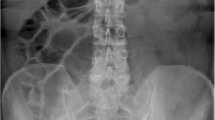Abstract
A 52-year-old woman developed an acute pancreatitis 7 years after gastric banding for morbid obesity. The patient presented a stable weight loss. Three months before, a radiological band calibration showed a normal position of the band. Investigations revealed that the pancreatitis was related to the presence of gallstones, complicated by a stone in the choledocic tract. The band migrated completely into the gastric lumen and passed far down the jejunum. The band was still connected to the port but the connecting tube did not follow the normal course of duodenum, entering the stomach in the middle of the greater curvature and getting out on the same side 5 cm more distad. The patient underwent first an endoscopic retrograde cholangiopancreatogram with sphinterectomy, then a laparoscopy that allowed us to remove the band, via jejunotomy, and the tube, which was outside the stomach. The postoperative course was uneventful.




Similar content being viewed by others
Reference
Abu-Abeid S, Keidar A, Gavert N, et al. The clinical spectrum of band erosion following laparoscopic adjustable silicone gastric banding for morbid obesity. Surg Endosc 2003;17:861–3.
Meir E, Van Baden M. Laparoscopic adjustable silicone gastric banding and band erosion: personal experience and hypotheses. Obes Surg 1999;9:191–3.
Weiss H, Nehoda H, Labeck B, et al. Deflated adjustable gastric band migration through anterior gastric wall. Endoscopy 2000;32:S35.
Niville E, Dams A, Vlasselaers J, et al. Lap-Band® erosion: incidence and treatment. Obes Surg 2001;11:744–7.
Forsell P. Experience with the Swedish adjustable gastric band. In: Deitel M, editor. Update: surgery for the morbidly obese patient. Toronto: FD-Communications; 2000. p. 359–78.
Biagini J. Intragastric band erosion (correspondence). Obes Surg 2001;11:100.
Naim HJ, Gorecki PJ, Wise L. Early lap-band erosion associated with colonic inflammation: a case report and literature review. JSLS 2005;9:102–4.
Bueter M, Thalheimer A, Meyer D, Fein M. Band erosion and passage, causing small bowel obstruction. Obes Surg 2006;16:1679–82.
Wylezol M, Sitkiewicz T, Gluck M, Zubik R, Pardela M. Intra-abdominal abscess in the course of intragastric migration of an adjustable gastric band: a potentially life-threatening complication. Obes Surg 2006;1:102–4 (3).
Author information
Authors and Affiliations
Corresponding author
Rights and permissions
About this article
Cite this article
Lattuada, E., Zappa, M.A., Mozzi, E. et al. Concurrent Band and Tube Migration Following Acute Pancreatitis. OBES SURG 18, 329–331 (2008). https://doi.org/10.1007/s11695-007-9299-4
Received:
Accepted:
Published:
Issue Date:
DOI: https://doi.org/10.1007/s11695-007-9299-4




